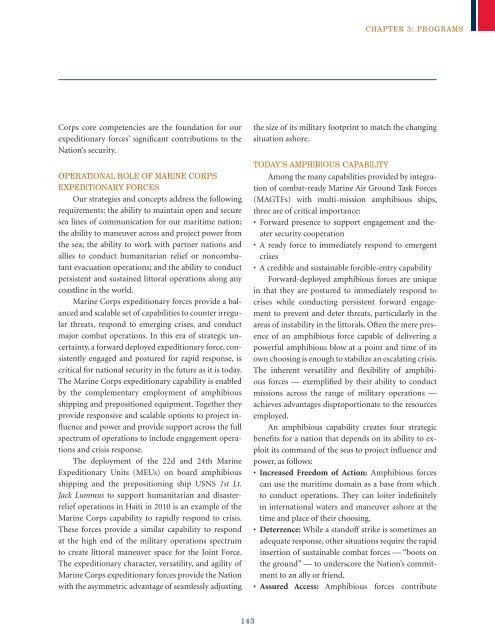USMC Concepts & Programs 2013 - Defense Innovation Marketplace
USMC Concepts & Programs 2013 - Defense Innovation Marketplace
USMC Concepts & Programs 2013 - Defense Innovation Marketplace
You also want an ePaper? Increase the reach of your titles
YUMPU automatically turns print PDFs into web optimized ePapers that Google loves.
chapter 3: programs<br />
Corps core competencies are the foundation for our<br />
expeditionary forces’ significant contributions to the<br />
Nation’s security.<br />
Operational Role of Marine Corps<br />
Expeditionary Forces<br />
Our strategies and concepts address the following<br />
requirements: the ability to maintain open and secure<br />
sea lines of communication for our maritime nation;<br />
the ability to maneuver across and project power from<br />
the sea; the ability to work with partner nations and<br />
allies to conduct humanitarian relief or noncombatant<br />
evacuation operations; and the ability to conduct<br />
persistent and sustained littoral operations along any<br />
coastline in the world.<br />
Marine Corps expeditionary forces provide a balanced<br />
and scalable set of capabilities to counter irregular<br />
threats, respond to emerging crises, and conduct<br />
major combat operations. In this era of strategic uncertainty,<br />
a forward deployed expeditionary force, consistently<br />
engaged and postured for rapid response, is<br />
critical for national security in the future as it is today.<br />
The Marine Corps expeditionary capability is enabled<br />
by the complementary employment of amphibious<br />
shipping and prepositioned equipment. Together they<br />
provide responsive and scalable options to project influence<br />
and power and provide support across the full<br />
spectrum of operations to include engagement operations<br />
and crisis response.<br />
The deployment of the 22d and 24th Marine<br />
Expeditionary Units (MEUs) on board amphibious<br />
shipping and the prepositioning ship USNS 1st Lt.<br />
Jack Lummus to support humanitarian and disasterrelief<br />
operations in Haiti in 2010 is an example of the<br />
Marine Corps capability to rapidly respond to crisis.<br />
These forces provide a similar capability to respond<br />
at the high end of the military operations spectrum<br />
to create littoral maneuver space for the Joint Force.<br />
The expeditionary character, versatility, and agility of<br />
Marine Corps expeditionary forces provide the Nation<br />
with the asymmetric advantage of seamlessly adjusting<br />
the size of its military footprint to match the changing<br />
situation ashore.<br />
Today’s Amphibious Capability<br />
Among the many capabilities provided by integration<br />
of combat-ready Marine Air Ground Task Forces<br />
(MAGTFs) with multi-mission amphibious ships,<br />
three are of critical importance:<br />
• Forward presence to support engagement and theater<br />
security cooperation<br />
• A ready force to immediately respond to emergent<br />
crises<br />
• A credible and sustainable forcible-entry capability<br />
Forward-deployed amphibious forces are unique<br />
in that they are postured to immediately respond to<br />
crises while conducting persistent forward engagement<br />
to prevent and deter threats, particularly in the<br />
areas of instability in the littorals. Often the mere presence<br />
of an amphibious force capable of delivering a<br />
powerful amphibious blow at a point and time of its<br />
own choosing is enough to stabilize an escalating crisis.<br />
The inherent versatility and flexibility of amphibious<br />
forces — exemplified by their ability to conduct<br />
missions across the range of military operations —<br />
achieves advantages disproportionate to the resources<br />
employed.<br />
An amphibious capability creates four strategic<br />
benefits for a nation that depends on its ability to exploit<br />
its command of the seas to project influence and<br />
power, as follows:<br />
• Increased Freedom of Action: Amphibious forces<br />
can use the maritime domain as a base from which<br />
to conduct operations. They can loiter indefinitely<br />
in international waters and maneuver ashore at the<br />
time and place of their choosing.<br />
• Deterrence: While a standoff strike is sometimes an<br />
adequate response, other situations require the rapid<br />
insertion of sustainable combat forces — “boots on<br />
the ground” — to underscore the Nation’s commitment<br />
to an ally or friend.<br />
• Assured Access: Amphibious forces contribute<br />
143

















